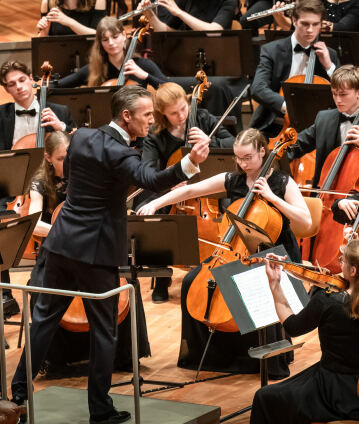The National Youth Orchestra of Germany with Mahler’s Ninth Symphony

For the Berliner Philharmoniker, the National Youth Orchestra of Germany is more than just a highly talented young orchestra: as its patron, the orchestra feels a special bond with this elite youth ensemble. This year, under the direction of Alexander Shelley, it will perform Mahler’s Ninth, the composer’s last completed symphony. With its fractured, inconsistent tonal language, it is regarded as Mahler’s musical legacy – and at the same time as a precursor of musical Modernism.
After his departure from the position of director of Vienna’s Hofoper, Gustav Mahler’s conducting career took a final spectacular turn with his move to New York in 1907. However, the composer continued to write his great symphonies in the old world. The Ninth Symphony, for example, was largely composed in the summer of 1909 in the South Tyrolean village of Toblach.
The legend of the Ninth Symphony as the last symphony of great composers refers above all to Beethoven, Bruckner and Mahler. As his wife Alma recalled, Mahler was “afraid of the term Ninth Symphony, as neither Beethoven nor Bruckner had reached the Tenth”. And although the composer did indeed “reach” his Tenth, he died before he could complete it.
Regardless of any numerical mysticism, Mahler’s Ninth is undoubtedly a work of farewell – he wrote the following comment, among others, in the draft of the score: “O Schönheit! Liebe! Lebt wohl! Lebt wohl! Welt! Lebe wohl!” (O beauty! Love! Farewell! Farewell! World! Farewell!). The two syllables “Lebt wohl” can be assigned to the motif of the descending whole tone, which plays a leading role in the first movement of the work.
The structure of Mahler’s last completed symphony is unusual: two poignant, slow songs of farewell frame two scherzo-like movements. The latter are characterised by folk and dance-like inflections and a sometimes grotesque vitality. When the strings recede to the limits of audibility in the quadruple piano at the end of the finale, the music seems to have left everything earthly behind.
The National Youth Orchestra of Germany performs Mahler’s monumental work under the baton of English conductor Alexander Shelley, who has already conducted the ensemble on several occasions at its annual performance in the Philharmonie Berlin.
© 2024 Berlin Phil Media GmbH
Artists
Our recommendations
- The National Youth Orchestra of Germany and National Youth Ballet perform Mendelssohn’s “Reformation” Symphony
- The National Youth Orchestra of Germany and the National Youth Ballet with Ravel and Strauss
- The National Youth Orchestra of Germany and the National Youth Ballet
- Herbert Blomstedt and Leif Ove Andsnes
- “Late Night” concert with Simon Rattle and a new masterpiece
- Manfred Honeck and Yo-Yo Ma at the Easter Festival